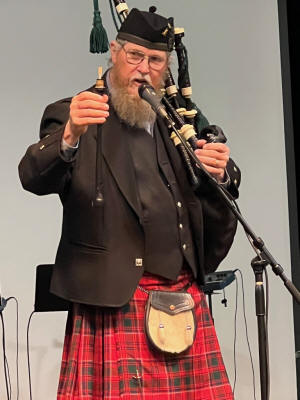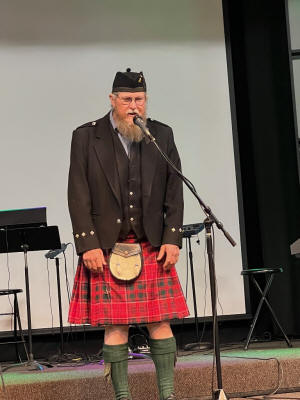|
 Though
often associated with old Scotland, and fire departments, the
standard bagpipe is not a widely utilized instrument. One reason may
be that the hauntingly beautiful sounds that come from the bagpipe
required an intense amount of knowledge as well as dexterity. Though
often associated with old Scotland, and fire departments, the
standard bagpipe is not a widely utilized instrument. One reason may
be that the hauntingly beautiful sounds that come from the bagpipe
required an intense amount of knowledge as well as dexterity.
Joe Readnour from Moweaqua was the guest, who played various
bagpipes for the group, talking about the differences between each
one, not only in how they are played, but also in how they sound.

The first bagpipe Readnour demonstrated was the
“Highland” bagpipe. These are typically played outside because they
are louder and have a higher pitched tone that resonates through the
air. These were also known as the being the “war instrument” for
those same reasons.
The bag of the pipe is usually made of cow hide or sheep skin. To
keep the animal hide supple, it must be treated annually with bees
wax and honey this also keeps the stitches from drying out.

This pipe can be played by mouth or, it can be played
solely utilizing the bellows. Either way the air is expelled out by
passing through reeds that create the varying tones. There are pipes
with this instrument that are generally leaned on the shoulder.
These are called drones and are responsible for the haunting dirge
sound of the bagpipes.
All bagpipes are handmade usually from African Black Wood and iron.
Because of their construction from iron, they seldom make it through
customs without being suspect.

Readnour was wearing a kilt that was labeled as the
“Grant Clan” tartan. Colors and hardware worn with the Kilt are used
to identify the “clan” and goes back to the olden days of Scotland.
Original kilts are made of wool and often began life as a blanket
with local or regional colors derived from local plants and dyes.
[to top of second column] |

The original kilt took a good deal of time to put on,
and most of the time involved rolling on the ground to get into it.
The original kilts were worn in war, but after a time, they were
revamped a bit because the body of the garment was cumbersome in
battle. As a result, the top part of the uniform was cut off and the
more recognizable “skirt” is what is more often associated with the
word ‘kilt’ today.
The second bagpipe Readnour demonstrated was the
Irish bagpipe. This pipe is smaller in structure and has a softer,
sweeter more mellow sound than the high-pitched Highlander.
VIDEO IRISH PIPE BLUEGRASS –
Readnour plays I know who holds tomorrow on the Irish bagpipe
VIDEO IRISH VIDEO – Readnour plays Rocky
Top on the Irish Bagpipe
The third bagpipe Readnour showed off was the English Bagpipe. This
is a much more complicated instrument, and harder to master. It is
also more difficult to ‘wear’ than the other two. Securing the
instrument to the body takes more time than with the other two.
_small.jpg)
ENGLISH PIPES VIDEO –
Readnour plays Amazing Grace on the English Bagpipe
The English pipe does not utilize a mouthpiece. The bellows of the
instrument is attached to the player’s waist and arm. Air pumped
through it with the arm compressing the bellows against the waist.
The hands are used to stroke the variety of keys on the pipe which
create the different notes and cords of a song. This instrument
takes the greatest amount of concentration, dexterity, and practice
to successfully play recognizable music.

Some of the guests on Wednesday said they thought it
was an amazing program, and they were impressed by Readnour’s
extensive knowledge of the bagpipes.
The Jolly Seniors meet the third Wednesday of the month at Lincoln
Christian Church from 10 a.m. to 12:30 p.m. in the Fellowship
Center. Lunch is served by Guzzardo's and costs only $4.00. Guests
may also bring finger foods or treats if you wish.
Public is invited.
[Karen Castelein] |